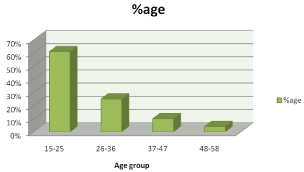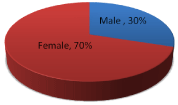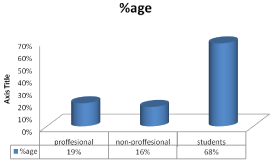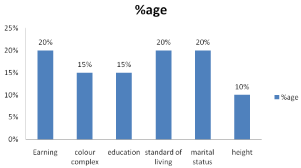
Research Article
Ann Depress Anxiety. 2016; 3(2): 1081.
Complexes Leads to Depression
Ashraf Z*, Amjad R, Shafaq S, Sultan S, Babar T, Idrees E and Murtaza T
Department of Pharmacy, Jinnah University for Women, Pakistan
Corresponding author: Zehra Ashraf, Department of Pharmacy, Jinnah University for Women, Karachi, Pakistan
Received: July 16, 2016; Accepted: September 14, 2016; Published: September 16, 2016
Abstract
Multiple complexes are the main reasons behind depression of many people. Its causes vary from person to person but the central point revolves around the complexes. Depression is a serious medical condition in which person feels blue or sad characterized by mental or psychotic disorders.
The aim of study was to assert the influences of the severity of complexity leads to depression.
A survey was conducted in Pakistan’s largest city of Pakistan showed that the complexes are the highest in age group of 15-25 i.e. 61%, it is the most common in students 68%, females 70% and unmarried people 80%. The reasons of complexes are shown in less income people than others. It analyses that females 70% are more victims comparative to males 80%, unmarried and students 68% were suffering in complexes
Keywords: Antidepressants; Behavior, Depression; Stress
Introduction
Complexes are a core pattern of emotions, memories, perceptions, and wishes in the personal unconscious organized around a common theme, such as power or status. There is just a borderline between complexes turning into depression which is faith and lack of confidence in your personality leading to a serious medical condition of “Depression”. Multiple complexes are the main reasons behind depression of many a people. Its causes vary from person to person but the central point revolves around the complexes.
Depression is a serious medical condition in which person feels blue or sad characterized by mental or psychotic disorders accomplished by hopelessness, sadness, appetite imbalances as well as problems in thinking or facing ground realities of life and feels anxiety with low-self worth which may be due to compulsive disorder or social problems [1].
Persistent rumination, severe complex problems are also reported in depressed patients proving their social phobias [2]. These trigger behavior and emotions in response to different environmental stresses or social nature which may induce problems related to psychomotor changes [3]. Depressed people believe their ruminations as an insight into their problems; feel often concerned about their problems, which they perceive to be complex, severe, and difficult to resolve, but clinician’s as pathological (difficulty for patient to concentrate [4]. Depression is commonly considered to be a neuro-chemical disorder, often treated with antidepressants. Relative to placebo, the response to antidepressants often fails to reach clinical significance except for the most severely depressed patients [4]. Depressive Stress response mechanisms can produce impairments when responding to a stressor [5].
Depression induces changes in body systems. Specifically, depressed affect: (1) attention control, which makes them intrusive, persistent, resistant to distraction, and difficult to suppress; (2) induces anhedonia (the inability to derive pleasure from activities such as eating or sex), sleeping, and eating patterns; and (3) promotes psychomotor no changes that reduce exposure to stimuli that could disrupt processing (e.g., desire for social isolation, loss of appetite) [6].
Stress response mechanisms often have to make tradeoffs between fitness-related goals and human psychology to produce an effective response against triggering problems like in case of fever. The mechanism of depression is predicated on stress response that arouses by completely different issues that influence changes in anatomy to boost the analytical issues. Its aim is to assist a person by giving solutions associated with the strain or issue [7]. The necessary symptoms of depression as well as loss of weight, cognitive content disturbance, feeling guilty, arousal early within the morning etc. [8] the foremost necessary arouse of depression in group could be a social complexes either owing to social rank or resources folks feel hesitate or embarrassing whereas speaking or intake [9].
People additionally Janus-faced social dilemmas within which advantages are supported self-interest meantime the coordination should be sturdy [10].
The aim of study was to assert the influences of the severity of complexity leads to depression.
Methodology
Site of study
Our survey was conducted through different areas of the biggest city of Islamic country Pakistan i.e. Karachi. It is economic hub of Pakistan.
Pattern of study
A cross-sectional based survey was conducted by general public of Karachi through closed-ended questionnaires containing 15- 18 multiple choice questions from randomly selected people with multiple range of answers to choose from. Survey was scrutinized using simple English language the survey was managed among 200 adult individuals including male and female of different age groups.
Results
Our article is basically survey based which is divided into 4 different categories, first category is divided into different age group and check the level of complexes, the result showed that age group 15-25 (61%), 26-36 (25%), 37-47 (10%), 48-58 (4%) are suffered in complexes, as shown in Figure 1 & Table 1. Second category is level of complexes among gender i.e. males (30%) & females (70%) shown in Figure 2 & Table 2, third category is level of complexes common in marital status (married 20% and single 80%) shown in Figure 3 & Table 3, forth category is Level of complexes among different working status in professionals 19%, non-professional 16% and students 68% shown in Figure 4 & Table 4. In survey also focus reasons of complexes i.e. color complex 15 % earning 20%, height 10%, standard of living 20%, lack of education 15%, and delay marriage complex is 20%, as shown in Figure 5 & Table 5. Complexes lead towards depression; symptoms of depression are trouble in sleeping 38%, avoid meeting with others 43%, easily disappointed 10% and mood swing 9% as shown in Figure 6 & Table 6.

Figure 1: Level of complexes in different age group.
Age group
%age
15-25
61%
26-36
25%
37-47
10%
48-58
4%
Table 1: Level of complexes in different age group.

Figure 2: Level of complexes among gender.
Gender
%age
Male
30%
Female
70%
Table 2: Level of complexes among gender.

Figure 3: Level of complexes among marital status.
Status
%age
Married
20%
Single
80%
Table 3: Level of complexes among marital status.

Figure 4: Level of complexes among different working status.
Working Status
%age
Professional
19%
Non-professional
16%
Students
68%
Table 4: Level of complexes among different working status.

Figure 5: Causes of complexes.
Causes of Complexity
%age
Earning
20%
Color complex
15%
Education
15%
Standard of living
20%
Marital status
20%
Height
10%
Table 5: Causes of complexes.

Figure 6: Complexes leads to depression.
Complexes leads to depression
Figure 1 Complexes leads to depression
%age
Trouble in sleeping
38%
Avoid meeting with others
43%
Easily disappointed
10%
Mood swings
9%
Table 6: Complexes leads to depression.
Conclusion
A survey was conducted in Pakistan’s largest city of Pakistan showed that the complexes are the highest in age group of 15-25 i.e. 61%; it is the most common in students 68%, females 70% and unmarried people 80%. The reasons of complexes are shown in less income people than others. It analyses that females 70% are more victims comparative to males 80%, unmarried and students 68% were suffering in complexes. The reasons of complexes include those who were not satisfied with their standards of living, life styles or marital life, color complex issue, lack of educations. Due to complexes people move towards depression Our survey showed that about 43% Pakistani population hesitate in meeting with others, some more problems are trouble in sleeping, easily disappointed, swinging mood.
References
- DSM-5 American Psychiatric Association. Diagnostic and statistical manual of mental disorders. Arlington: American Psychiatric Publishing. 2013.
- Koran LM, Thienemann ML, Davenport R. Quality of life for patients with obsessive-compulsive disorder. The American journal of psychiatry. 1996; 153: 783.
- Desjarlais R. World mental health: problems and priorities in low-income countries. Oxford University Press, USA. 1996.
- Harris T. Depression in women and its squeal. Journal of Psychosomatic Research. 2003; 54: 103-112.
- Bonime W. Collaborative psychoanalysis: Anxiety, depression, dreams, and personality change. Fairleigh Dickinson Univ Press. 1989.
- Alem A, Jacobsson L, Araya M, Kebede D, Kullgren G. How are mental disorders seen and where is help sought in a rural Ethiopian community? A key informant study in Butajira, Ethiopia. Acta Psychiatrica Scandinavica. 1999; 397: 40-47.
- Prior L, Wood F, Lewis G, Pill R. Stigma revisited disclosure of emotional problems in primary care consultations in Wales. Social science & medicine. 2003; 56: 2191-2200.
- American Psychiatric Association. Work Group on Borderline Personality Disorder. Practice guideline for the treatment of patients with borderline personality disorder. 2001; 158: 1-52.
- Mulder RT. Personality pathology and treatment outcome in major depression: a review. American Journal of Psychiatry. 2002.
- Brown C, Schulberg HC, Madonia MJ, Shear MK, Houck PR. Treatment outcomes for primary care patients with major depression and lifetime anxiety disorders. The American journal of psychiatry. 1996; 153: 1293.